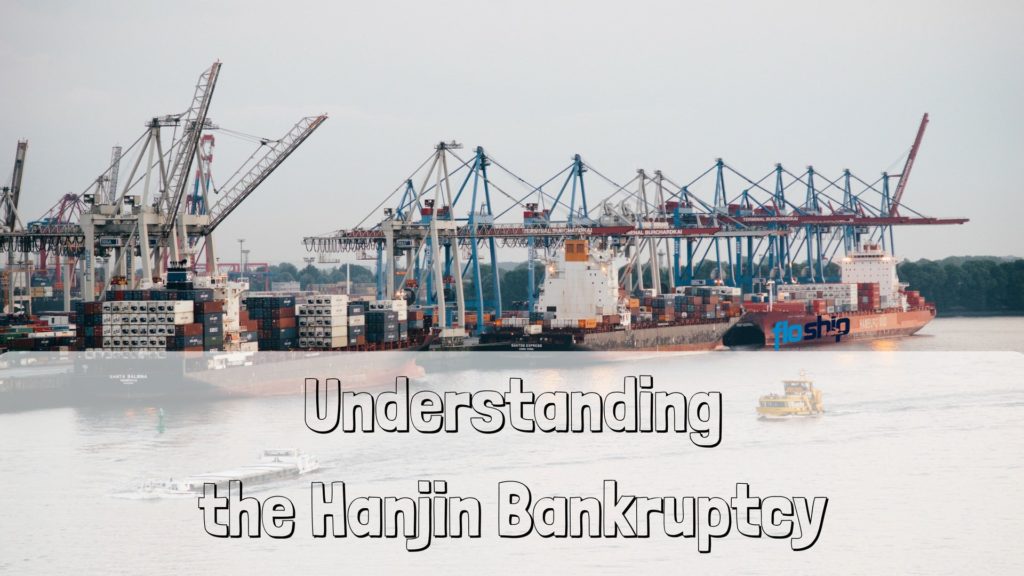When news broke that Hanjin Shipping Company would file for bankruptcy, some people were shocked. Some were surprised that such a massive organization was so financially depleted it could not stay open.
Others, once the infamous fallout of the bankruptcy became known—including numerous ships stranded at sea when their destinations refused to accept their cargo, or simply didn’t have enough money to complete the trips, hundreds of actual people floating in offshore waters or miles away from coastlines—were incensed that the company’s board of directors hadn’t planned more diligently and carefully for the impending doom.
Of course, if you were stuck out at sea with no end in sight, you might be a tad upset too. Or a lot upset.
It’s fairly common for large companies to go bankrupt—airlines are notorious for doing so with regularity—but since Hanjin was responsible for a large portion of international trade and commerce, it’s possible the ramifications of its insolvency will be a bit more complicated.
It’s also possible you might not get those gifts you ordered for Christmas, which is almost as bad as being stranded at sea.
Retailers especially are frustrated over whether intended shipments will come in, so close to the holiday season. The coming months will be frantic as the company itself, retailers, freight associations, and national governments deal with the ramifications of the bankruptcy.
This article will give you a crash course in the still-brewing controversy.

Image from www.sdcexec.com
What’s Hanjin Shipping?
No, it’s not a kind of shipping—it’s one of the top ten container carrier companies in the whole world, and a unit of one of Korea’s largest conglomerates.
A “container carrier” is a kind of cargo ship that stores all of its freight in massive, oblong units called intermodal containers. They are called intermodal because the same container can be used on many different “modes” of travel—ship, truck, trains—without having to unpack and reload all the individual cargo.
You now know more about container’s than you ever thought necessary.
A few details on Hanjin:
- It was founded in 1977 as Hanjin Container Lines, a member of The Hanjin Group, a family-run holding company begun in 1945 that also owns Korea’s largest airline, Korea Air.
- It was headquartered in Seoul, and the company owned a fleet of 141 vessels transporting diverse freight (besides the containers, they also carried bulk cargo, oil, and natural gases).
- Its ships were welcomed in over 70 ports across more than 40 nations in Europe, Asia, and the Americas.
By the late 1980s its net profit was over $18 million, and global expansion through new trade routes and agreements throughout the 1990s upped its competition and pushed it higher on the list of the world’s largest carrier companies.
The plummet of Korean currency values in 1997 was the beginning of an economic crisis, and in 1999 The Hanjin Group was slapped with a 541.6 billion won ($445 million US) fine by the Korean government for extensive tax evasion—because of unreported income of about W 1.08 trillion (3.8 billion of which was shuffled by Hanjin Shipping into offshore accounts some 16 times).
Under intense government scrutiny, the Group instituted several reforms, including the dismissal and replacement of various company presidents and increased partnership with other companies.
They also expanded with a more stable online presence with other carriers in 2001, which allowed the various parties in international shipping to communicate with one another, set prices, and do contracting and tracking of shipments all online. By June of that year, Hanjin Shipping was making over 232 billion won in profit—but lost over 15 billion due to hikes in exchange rates. The company became more stable in later years, and by 2014 was sold for $1.8 billion US to a new chairman of the Group, Cho-yang Ho.
Did you follow all those twists and turns? Yes, it’s a bit complicated, but stay with it.

Image via http://www.arkasdenizcilik.com.tr
So why did it collapse?
The company itself is still trying to figure that out. International trade has significantly slowed in recent years, and that means less demand for the company’s services (all cargo companies have faced similar deficits, although Hanjin has been hit especially hard).
Ultimately, it seems to be a combination of a highly competitive industry and an inability to raise necessary capital—with the Korean government refusing a bailout in part because a government agency, the Korea Development Bank, was one of its creditors that sued Hanjin.
Indeed, tensions between Hanjin and its creditors seem to be a major part of the insolvency. The government wanted Hanjin to raise its own capital, while the company demanded that its creditors invest more funds. The company only filed for bankruptcy after repeated attempts to raise that capital failed. (They presented a plan to investors to raise several billion dollars themselves, but the Korea Development Bank, which heads its coalition of creditors, rejected the plan as inadequate. Shortly thereafter, Hanjin declared bankruptcy.)
Now, it’s filing for bankruptcy protection in numerous nations, a move which will protect its ships and their cargo from repossession by creditors and would also protect their limited assets from being taken. Debt restructuring and reorganization would then be possible and might allow the company a limited, if real, comeback.
If the creditors do the seize ships, many of which are heading for US ports and from them to American companies and retailers, it will create further problems for Hanjin and the businesses waiting for their shipments.

Image via www.wsj.com
The company is approximately 5.5 billion dollars in debt. Nearly 400,000 containers remain stranded on ships idling at sea, and Samsung has reported that it has nearly $38 million worth of its products stuck on two of Hanjin’s ships.
Given that their phones regularly catch fire, maybe this isn’t a bad thing.
So basically, this is really bad for Hanjin. They’re out of money, their cargo is at sea, and they’re not sure what’s going to happen.
What are some implications of the bankruptcy?
One could argue the old cliché that “money makes the world go ‘round” became a cliché because of situations like Hanjin’s. There are issues all around: Ports won’t allow Hanjin ships in because they are afraid the bankrupt company won’t be able to cover the necessary docking and unloading fees.
Even if they do port, creditors may be waiting to seize cargo and the ships themselves. If they can port and unload free of creditor interference, some companies (such as furniture giant Ashley Home, which uses Hanjin to deliver its pieces to JCPenney stores nationwide) are tied up in negotiations with the shipping company—Hanjin demands full payment for transporting the goods, while Ashley wants to be compensated for having to absorb the cost of storing empty containers and other equipment.
US retailers may or may not be prepared for any delay in receiving shipments, which could be immensely problematic during the upcoming holiday season.

Image via www.joc.com
There is also the matter of the $14 billion worth of merchandise and cargo simply floating on sea, marooned in offshore waters and the occasional port—stuck in limbo because of lack of funds to enter port or in some cases even complete the journey.
All those things you ordered for Christmas? They could still be floating out at sea.
The Hanjin Group’s chairman transferred some $36 million to the shipper to ensure that some of its cargo will be unloaded, and with additional funds recently secured from Hanjin’s sister company, Korea Air, the rest of the cargo should be able to unload. Hanjin estimates that ninety percent of its ships should be unloaded by October’s end, and leased ships are being returned to their owners. Others are being sold.

Image via www.hanjin.com
Nearly one hundred in-transit ships have been affected by the collapse. (128 of Hanjin’s 141 ships are currently operating.) Most of those have simply been denied entrance into port due to unpaid bills, but some have been seized by creditors. Some companies—like the one who sent hundreds of containers of seafood from Vietnam to Europe—are debating whether to complete the journey, which will cost thousands of dollars per container (and possibly be denied port at its end), or to return to the sending nation…which will also cost an exorbitant amount, often as much as making the journey to the original destination.
Numerous crewmembers are stranded at sea, separated from their families and legally prohibited (often by actual security guards) from leaving the ships unless there is a medical emergency. Many are uncertain as to what the future holds; it all depends on what Hanjin is able to accomplish in its negotiations with ports and the various laws of each nation. (One New Jersey judge denied Hanjin creditors’ request to repossess cargo, on the grounds that so doing would be catastrophic for the progression of trade.) Some crews are bracing themselves and their freight for monsoons, which given their being stranded in the open sea are a real threat.
If you ever thought being a sailor would be fun, this may help you reconsider.
Conclusion
It is unclear precisely where the next months will find Hanjin and the hundreds of companies which rely on its services for their own operation. If anything, this saga demonstrates how small and interdependent the world has become—and how fragile that ecosystem truly is.
Logistics and Ecommerce Post
- Goodbye Cyber Monday, It’s Fulfillment Tuesday!
- The Complete Guide to Shopify Order Fulfillment’s Third-Party Warehouses
- 6 Steps to Find an Exceptional Fulfillment Center [Awesome Simple]
- Cross-Docking Forget Warehousing and Ship Efficiently

Ready To Upgrade Your Logistic Solution?
Speak to Floship ecommerce logistic consultant about improving your global support chain today





